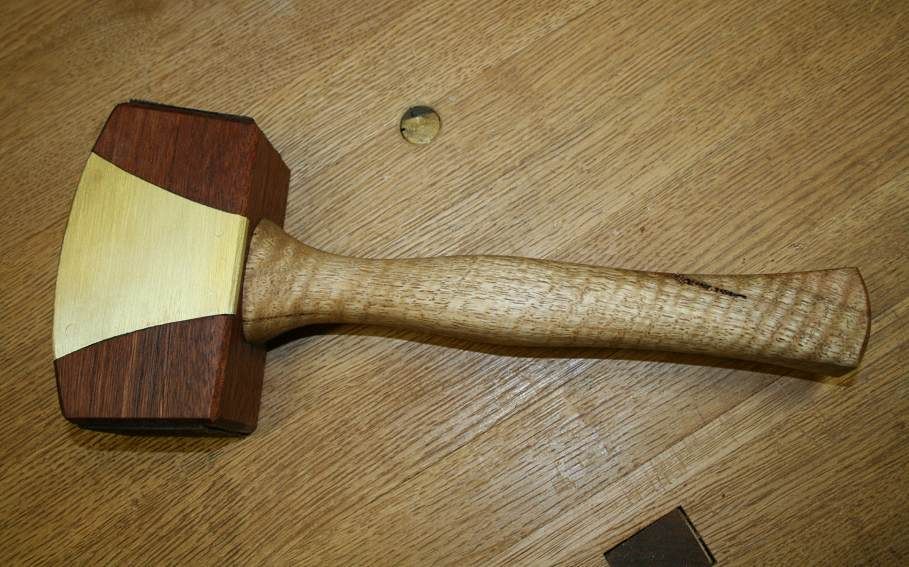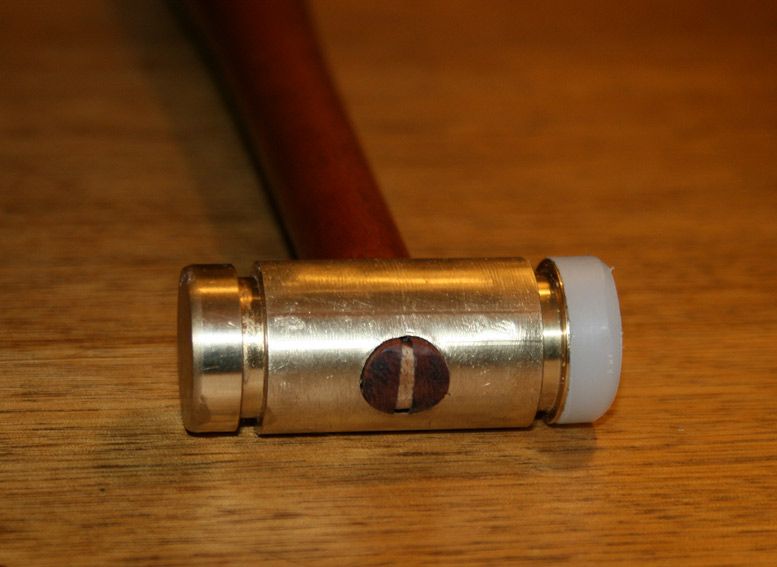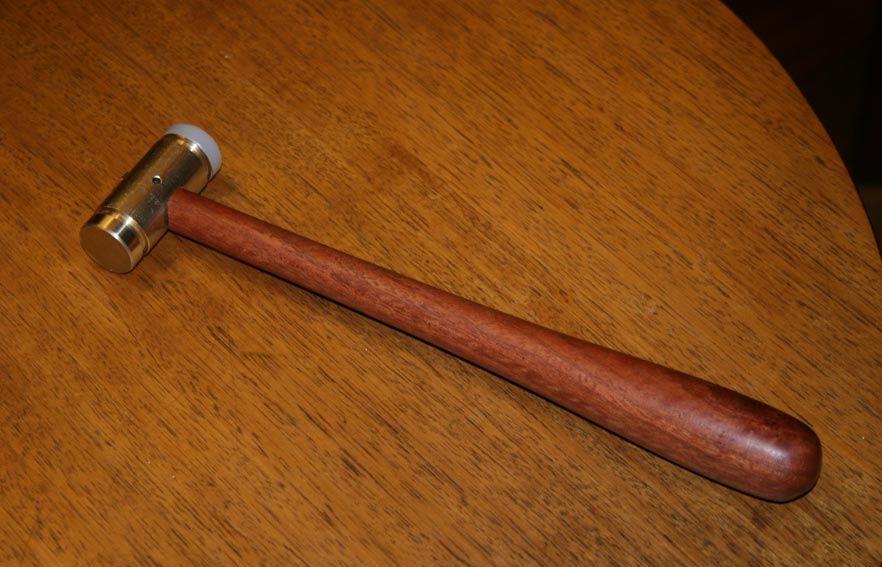 Needs Pictures: 0
Needs Pictures: 0
 Picture(s) thanks: 0
Picture(s) thanks: 0
Results 1 to 15 of 25
-
19th March 2015, 05:36 PM #1
 New Member
New Member











- Join Date
- Mar 2015
- Location
- Australia
- Posts
- 2
 Australian Hardwood for Joiners mallet
Australian Hardwood for Joiners mallet
Hey guys,
I've just started getting into traditional woodworking and I'm loving it! I'm watching this bloke Peter Sellers on youtube and learning heaps.
My question is this: I want to make a joiners mallet for banging on chisels and whatnot, but the wood species recommended are all Norther Hemisphere trees (Texas Cedar Elm, Osage Orange). What Australian hardwood would be suitable for this kind of tool?
Thanks,
Chris
-
19th March 2015 05:36 PM # ADSGoogle Adsense Advertisement
- Join Date
- Always
- Location
- Advertising world
- Posts
- Many
-
19th March 2015, 05:44 PM #2
 .
.











- Join Date
- Feb 2006
- Location
- Perth
- Posts
- 27,793

Most of them are suitable.
Sheoak is pretty nice
-
19th March 2015, 05:59 PM #3
 GOLD MEMBER
GOLD MEMBER

- Join Date
- Jun 2014
- Location
- Seattle, Washington, USA
- Posts
- 1,857

So many it's hard to choose!
Gidgee is incredibly hard, heavy, and beautiful, but is also expensive. Buloke is the hardest wood in the world, and is beautiful. Make it out of Buloke and it will last a lifetime... a lifetime during which you will replace your chisel handles many times!
I think a good compromise between hardness, weight, aesthetic, and durability is She Oak. Chances are it will be harder than your chisels and will outlast them (unless you replace your chisel handles with something as hard or harder), and it has a good heft and is beautiful. I've turned a carver's mallet out of this and the user is very pleased.
Alternatively, you could use something like a hard eucalypt or Tasmanian myrtle. Both are hard and can be very heavy. These are more along the lines of commercial chisel handles in hardness.
On the topic of eucalypts... their long fibers make for good handles. Similar to Hickory (which is what we yanks make our axe handles and baseball bats out of), it is hefty but absorbs shock. That may be overthinking it though...
Aaaand speaking of overthinking, you can really go back and forth on this all day. "Well this wood will split!" "Oh yeah? Well this wood will break my chisels!" . You can be as empirical about it as you want but, at the end of the day, it's probably best to pick a hardwood that you enjoy looking at, that gets the job done, and that you're willing to accept may one day explode into two or more pieces following a chisel strike.
Good luck,
Luke
PS I should probably mention that I use a (perfectly functional) mallet I got for $8 at Bunnings, so ignore everything I just said.
-
19th March 2015, 06:15 PM #4

Originally I picked up one from a hardware store. Started to split straight away and it is still been used after 15 years.
I have turned a couple of them from what ever I had at hand. I am considering them as disposable.
-
19th March 2015, 06:33 PM #5

Hi Chris , I just made a mallet following the Paul sellers video, it was a good learning experience tho ive been doing woodworking for years, a tapered through mortise was a newie and his relaxed method to shaping with chisels and spokeshaves worked out. i wouldnt like to try it without a drill press. I just rushed it with some Blackbutt from a huge recently felled local tree, as he says its more about doing it and learning , try any hardwood,mine weighed a kilo, will do another slightly smaller, Rossco
Last edited by woodsurfer; 19th March 2015 at 06:37 PM. Reason: error
-
19th March 2015, 10:52 PM #6

Forgot about what is recommended, any Australian close grained hardwood will do the job as good as any northern hemisphere woods.
-
20th March 2015, 11:24 AM #7

I think you really need a few of various weights for different tasks. I had a wimpy hardware store beech mallet that was looking the worse for ware so one rainy afternoon decided to make a mans mallet out of ironbark. Very good practice chopping a tapered mortice out of that hard stuff. By that time the beech mallet was truley nackered.It was really good for big projects where a bit of belting is required but I soon realised I needed some others for lighter stuff. We are blessed with so many suitable heavy woods that its just a rummage in the off cuts corner or the firewood pile for material. I now mostly turn them and apply a wedged handle. Saves a lot of time and effort. Spotted gum would perhaps be the first pick for its shock absorbsion and has a fair weight. A good pick for all sorts of handles too. I have mentioned ironbark for real weight and I have also used one of the wattles. Not sure what one but hard and heavyish and local to the mountains. Picks are of a small plane setting mallet/hammer and the big ironbark job. I also have a couple of in between size ones.
Regards
John
-
20th March 2015, 02:00 PM #8

-
20th March 2015, 02:22 PM #9

Tools for all occasions I guess, but generally speaking should the mallet be slightly softer or harder than the chisel handle being struck?
-
20th March 2015, 02:29 PM #10

Hi Brett, beautifully posed question. In my case my feeble first attempt at a mallet , non tapered , was from a tip in FWW, you just made handle,and laminated a head around the handle,glued up.My beauty was in radiata, most unsuited, ive beat the crap out of it , glued back blowouts,ten years or so later its final job was to cut the tapered mortice,even used Aldi chisels to keep it Paul Sellers authentic,sorry for the lightweight post,Rossco
-
20th March 2015, 02:44 PM #11

Hmmmm.
 Not too bad an answer Rossco albeit a tad slippery.....
Not too bad an answer Rossco albeit a tad slippery.....
Ok, a couple of Qs then (and without having watched Sellar's video - yet):
1. What would be better - to have the laminate join through the striking face, or across the body. I can see a fault with either - across the face means the join might fracture (although the joint is supposed to be stronger than the timber), and across the body means either gluing end grain (bad idea), or not having the striking face as end grain (probably a bad idea)
2. Why a tapered mortise? Surely a glued in handle to a normal mortise would be just as good? I don't like the idea of non-glued tapered - I've seen too many handles come off even when wedged.
-
20th March 2015, 03:13 PM #12

The tapered mortice on the equally tapered handle means the thing tightens itself in use. The head can never fly off. Traditionalists dont see anything else as a real mallet. Quite clever in its simplisity. Anything else is just a lump of wood on a stick
 I do own a couple of said lumps on sticks and they work fine until the day the head flies off.
I do own a couple of said lumps on sticks and they work fine until the day the head flies off.
Regards
John
-
20th March 2015, 03:17 PM #13

Hi Brett, In his video, Paul says,laminated heads will fail, even if it takes 100 years. the two piece design allows breaking down to carry in a toolbox. its just simple time tested design,I showed it to some mates 50s/60s,they remembered making one in woodworking class, even the head size,6x4x3 inches.Its a piston fit, if loosens you have little extra handle on top.Leave the rest to more knowledgeable. the video is entertaining,Rossco
-
20th March 2015, 03:31 PM #14

-
20th March 2015, 04:56 PM #15

I'm sorry, but that handle design of Paul Sellers just makes for poor ergonomics. All because of the taper for a wedging effect.
A good handle allows for two secure hand positions - close up (choked) position for lighter work, and further out for heavy blows. A firm hold requires an oval shape and support for the heel of the hand.
Here is one I made (a big, heavy mallet for mortice work) ...

The taper is very important, but it can be made in a different manner - simply use a wedged tenon ...

Here is another wedged tenon, this time on a plane hammer ..

The handle on this one tapers, but it does so outward from the handle, and this provides the security that it will not fly out of your hand.

Regards from Perth
DerekVisit www.inthewoodshop.com for tutorials on constructing handtools, handtool reviews, and my trials and tribulations with furniture builds.
Similar Threads
-
Australian Hardwood Beads
By Kidbee in forum WOODWORK - GENERALReplies: 4Last Post: 22nd May 2014, 12:36 PM -
Australian Hardwood Pallets
By Damienol in forum TIMBERReplies: 12Last Post: 13th April 2014, 05:56 PM -
Joiners mallet
By jrock_au in forum WOODWORK - GENERALReplies: 16Last Post: 5th June 2013, 12:16 PM -
Best Australian hardwood for bench top
By Rambozo in forum TIMBERReplies: 10Last Post: 30th December 2012, 02:15 AM -
Cheapest Australian hardwood?
By benupton in forum TIMBERReplies: 15Last Post: 25th May 2010, 12:08 PM



 Thanks:
Thanks:  Likes:
Likes: 
 Reply With Quote
Reply With Quote
 I get it. The taper runs de udder way.
I get it. The taper runs de udder way. Or not.
Or not.

